Analyzing the Legal Rights of an Unmarried Father: A Detailed Case
VerifiedAdded on 2021/04/24
|5
|1382
|96
Case Study
AI Summary
This case study examines the legal rights of David, an unmarried father, concerning his son Michael. Despite not being legally married to Michael's mother, Mary, David can establish his parental rights through a DNA paternity test. The analysis refers to the Child Rights Act 1989 and relevant case law, such as Re C & V and Re W, Re B, to support the argument that David has equal rights to Michael, including the potential for custody and financial contribution. The study concludes that David should apply to the courts to assert his parental rights, and Mary should allow David to exercise his parental rights over Michael. Every child has the right to know who its parents are. Similarly, Michael has the right to know what role David plays and what right he has on him. Desklib offers comprehensive resources and solved assignments for students.
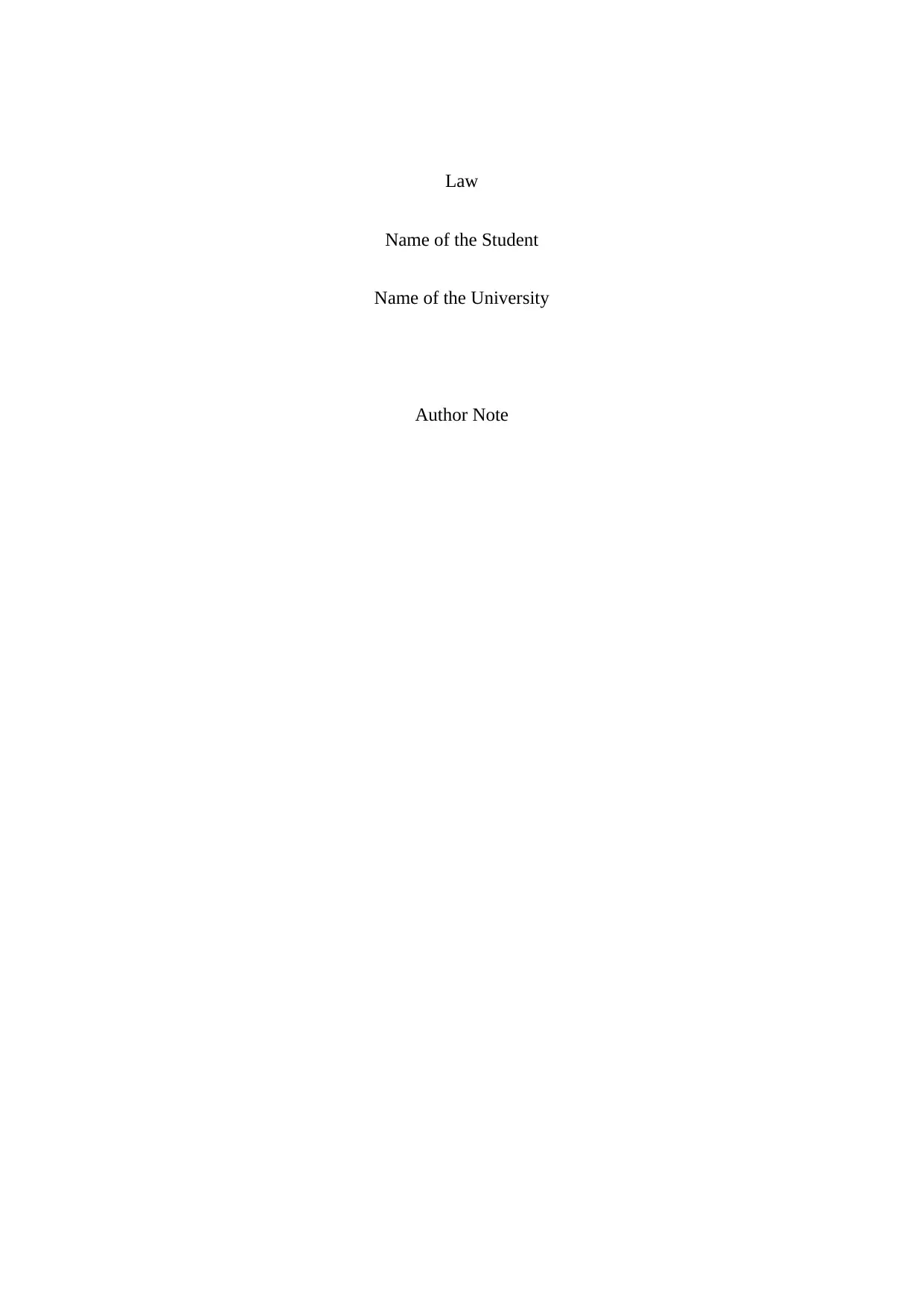
Law
Name of the Student
Name of the University
Author Note
Name of the Student
Name of the University
Author Note
Paraphrase This Document
Need a fresh take? Get an instant paraphrase of this document with our AI Paraphraser
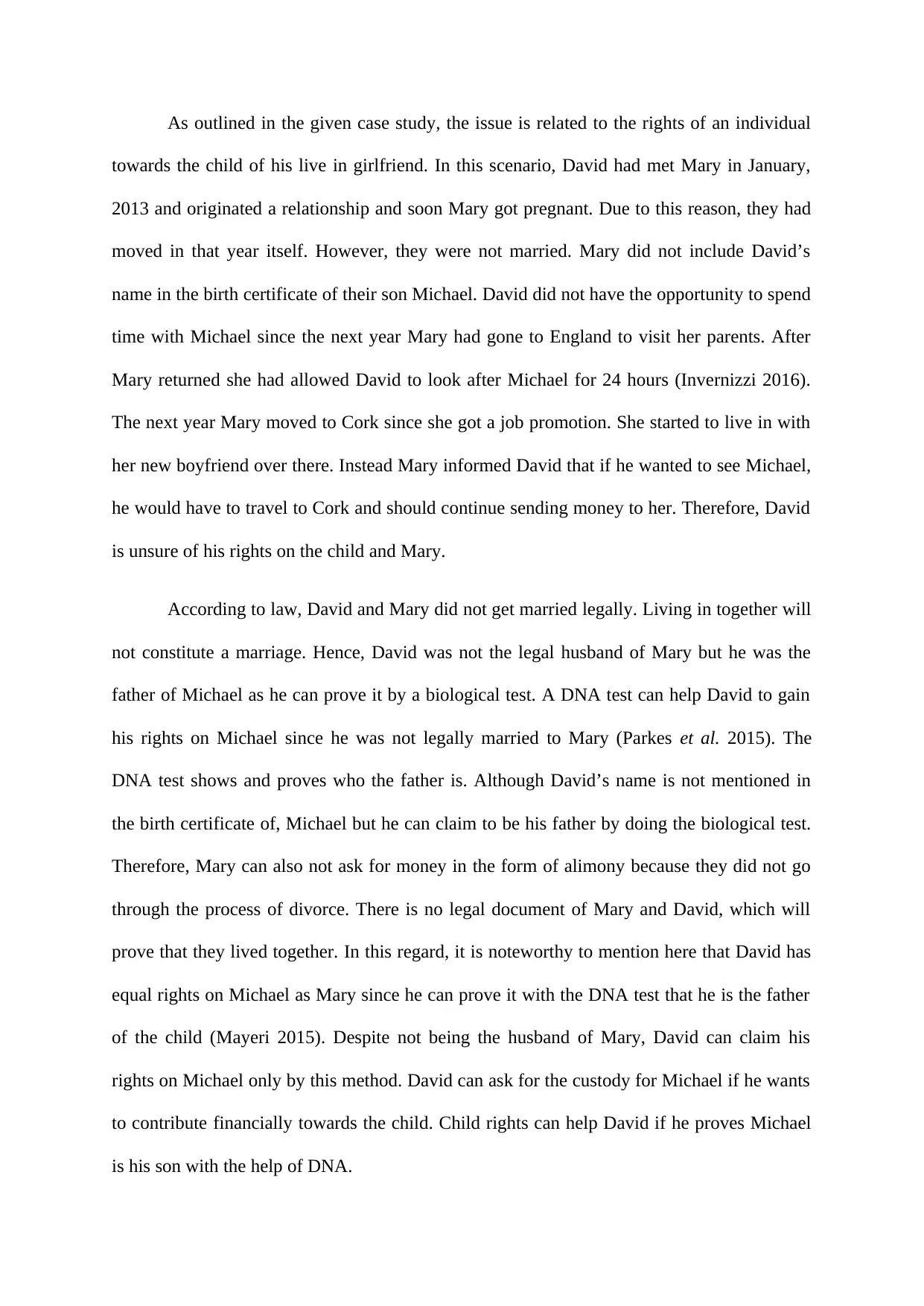
As outlined in the given case study, the issue is related to the rights of an individual
towards the child of his live in girlfriend. In this scenario, David had met Mary in January,
2013 and originated a relationship and soon Mary got pregnant. Due to this reason, they had
moved in that year itself. However, they were not married. Mary did not include David’s
name in the birth certificate of their son Michael. David did not have the opportunity to spend
time with Michael since the next year Mary had gone to England to visit her parents. After
Mary returned she had allowed David to look after Michael for 24 hours (Invernizzi 2016).
The next year Mary moved to Cork since she got a job promotion. She started to live in with
her new boyfriend over there. Instead Mary informed David that if he wanted to see Michael,
he would have to travel to Cork and should continue sending money to her. Therefore, David
is unsure of his rights on the child and Mary.
According to law, David and Mary did not get married legally. Living in together will
not constitute a marriage. Hence, David was not the legal husband of Mary but he was the
father of Michael as he can prove it by a biological test. A DNA test can help David to gain
his rights on Michael since he was not legally married to Mary (Parkes et al. 2015). The
DNA test shows and proves who the father is. Although David’s name is not mentioned in
the birth certificate of, Michael but he can claim to be his father by doing the biological test.
Therefore, Mary can also not ask for money in the form of alimony because they did not go
through the process of divorce. There is no legal document of Mary and David, which will
prove that they lived together. In this regard, it is noteworthy to mention here that David has
equal rights on Michael as Mary since he can prove it with the DNA test that he is the father
of the child (Mayeri 2015). Despite not being the husband of Mary, David can claim his
rights on Michael only by this method. David can ask for the custody for Michael if he wants
to contribute financially towards the child. Child rights can help David if he proves Michael
is his son with the help of DNA.
towards the child of his live in girlfriend. In this scenario, David had met Mary in January,
2013 and originated a relationship and soon Mary got pregnant. Due to this reason, they had
moved in that year itself. However, they were not married. Mary did not include David’s
name in the birth certificate of their son Michael. David did not have the opportunity to spend
time with Michael since the next year Mary had gone to England to visit her parents. After
Mary returned she had allowed David to look after Michael for 24 hours (Invernizzi 2016).
The next year Mary moved to Cork since she got a job promotion. She started to live in with
her new boyfriend over there. Instead Mary informed David that if he wanted to see Michael,
he would have to travel to Cork and should continue sending money to her. Therefore, David
is unsure of his rights on the child and Mary.
According to law, David and Mary did not get married legally. Living in together will
not constitute a marriage. Hence, David was not the legal husband of Mary but he was the
father of Michael as he can prove it by a biological test. A DNA test can help David to gain
his rights on Michael since he was not legally married to Mary (Parkes et al. 2015). The
DNA test shows and proves who the father is. Although David’s name is not mentioned in
the birth certificate of, Michael but he can claim to be his father by doing the biological test.
Therefore, Mary can also not ask for money in the form of alimony because they did not go
through the process of divorce. There is no legal document of Mary and David, which will
prove that they lived together. In this regard, it is noteworthy to mention here that David has
equal rights on Michael as Mary since he can prove it with the DNA test that he is the father
of the child (Mayeri 2015). Despite not being the husband of Mary, David can claim his
rights on Michael only by this method. David can ask for the custody for Michael if he wants
to contribute financially towards the child. Child rights can help David if he proves Michael
is his son with the help of DNA.
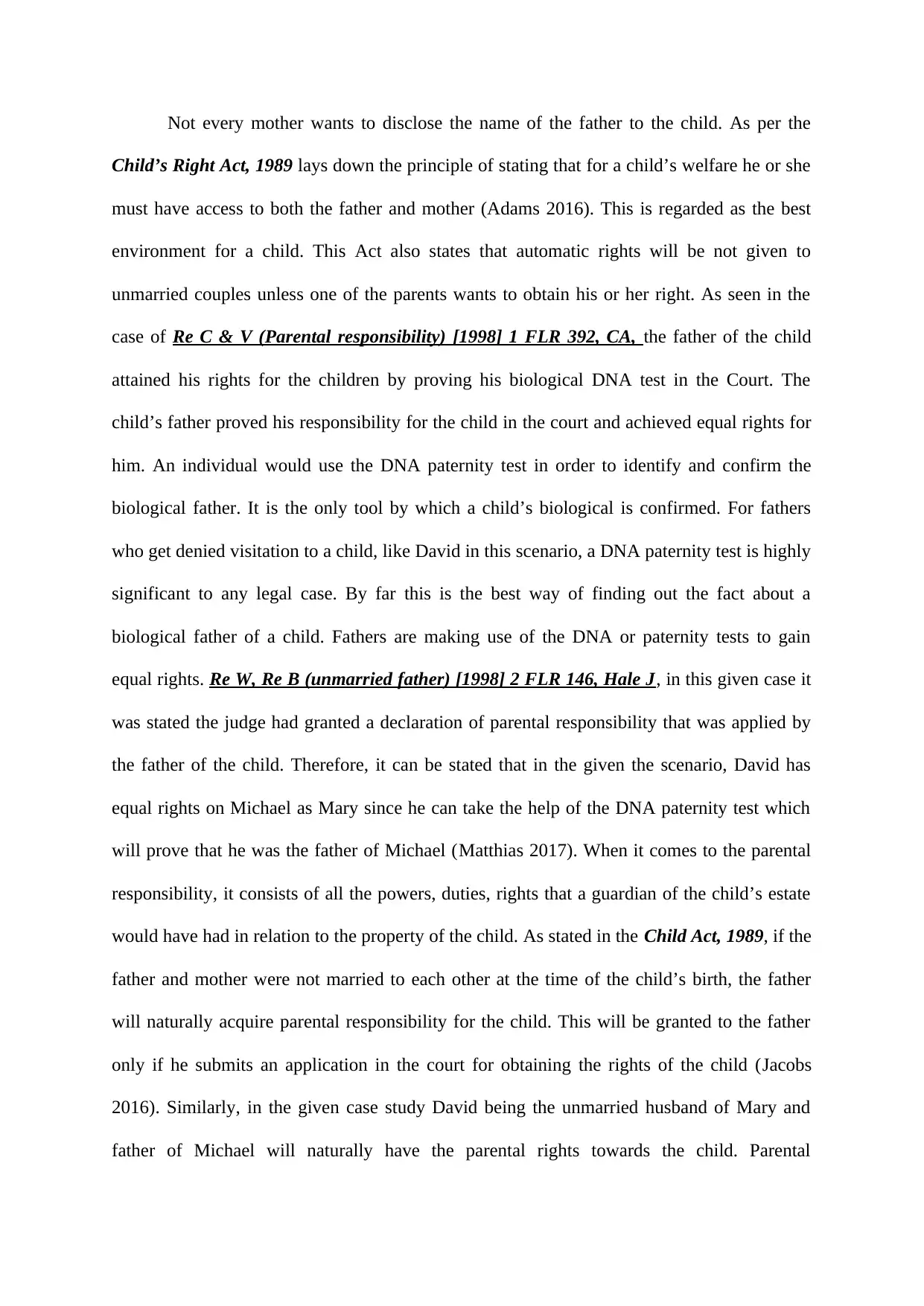
Not every mother wants to disclose the name of the father to the child. As per the
Child’s Right Act, 1989 lays down the principle of stating that for a child’s welfare he or she
must have access to both the father and mother (Adams 2016). This is regarded as the best
environment for a child. This Act also states that automatic rights will be not given to
unmarried couples unless one of the parents wants to obtain his or her right. As seen in the
case of Re C & V (Parental responsibility) [1998] 1 FLR 392, CA, the father of the child
attained his rights for the children by proving his biological DNA test in the Court. The
child’s father proved his responsibility for the child in the court and achieved equal rights for
him. An individual would use the DNA paternity test in order to identify and confirm the
biological father. It is the only tool by which a child’s biological is confirmed. For fathers
who get denied visitation to a child, like David in this scenario, a DNA paternity test is highly
significant to any legal case. By far this is the best way of finding out the fact about a
biological father of a child. Fathers are making use of the DNA or paternity tests to gain
equal rights. Re W, Re B (unmarried father) [1998] 2 FLR 146, Hale J, in this given case it
was stated the judge had granted a declaration of parental responsibility that was applied by
the father of the child. Therefore, it can be stated that in the given the scenario, David has
equal rights on Michael as Mary since he can take the help of the DNA paternity test which
will prove that he was the father of Michael (Matthias 2017). When it comes to the parental
responsibility, it consists of all the powers, duties, rights that a guardian of the child’s estate
would have had in relation to the property of the child. As stated in the Child Act, 1989, if the
father and mother were not married to each other at the time of the child’s birth, the father
will naturally acquire parental responsibility for the child. This will be granted to the father
only if he submits an application in the court for obtaining the rights of the child (Jacobs
2016). Similarly, in the given case study David being the unmarried husband of Mary and
father of Michael will naturally have the parental rights towards the child. Parental
Child’s Right Act, 1989 lays down the principle of stating that for a child’s welfare he or she
must have access to both the father and mother (Adams 2016). This is regarded as the best
environment for a child. This Act also states that automatic rights will be not given to
unmarried couples unless one of the parents wants to obtain his or her right. As seen in the
case of Re C & V (Parental responsibility) [1998] 1 FLR 392, CA, the father of the child
attained his rights for the children by proving his biological DNA test in the Court. The
child’s father proved his responsibility for the child in the court and achieved equal rights for
him. An individual would use the DNA paternity test in order to identify and confirm the
biological father. It is the only tool by which a child’s biological is confirmed. For fathers
who get denied visitation to a child, like David in this scenario, a DNA paternity test is highly
significant to any legal case. By far this is the best way of finding out the fact about a
biological father of a child. Fathers are making use of the DNA or paternity tests to gain
equal rights. Re W, Re B (unmarried father) [1998] 2 FLR 146, Hale J, in this given case it
was stated the judge had granted a declaration of parental responsibility that was applied by
the father of the child. Therefore, it can be stated that in the given the scenario, David has
equal rights on Michael as Mary since he can take the help of the DNA paternity test which
will prove that he was the father of Michael (Matthias 2017). When it comes to the parental
responsibility, it consists of all the powers, duties, rights that a guardian of the child’s estate
would have had in relation to the property of the child. As stated in the Child Act, 1989, if the
father and mother were not married to each other at the time of the child’s birth, the father
will naturally acquire parental responsibility for the child. This will be granted to the father
only if he submits an application in the court for obtaining the rights of the child (Jacobs
2016). Similarly, in the given case study David being the unmarried husband of Mary and
father of Michael will naturally have the parental rights towards the child. Parental
⊘ This is a preview!⊘
Do you want full access?
Subscribe today to unlock all pages.

Trusted by 1+ million students worldwide
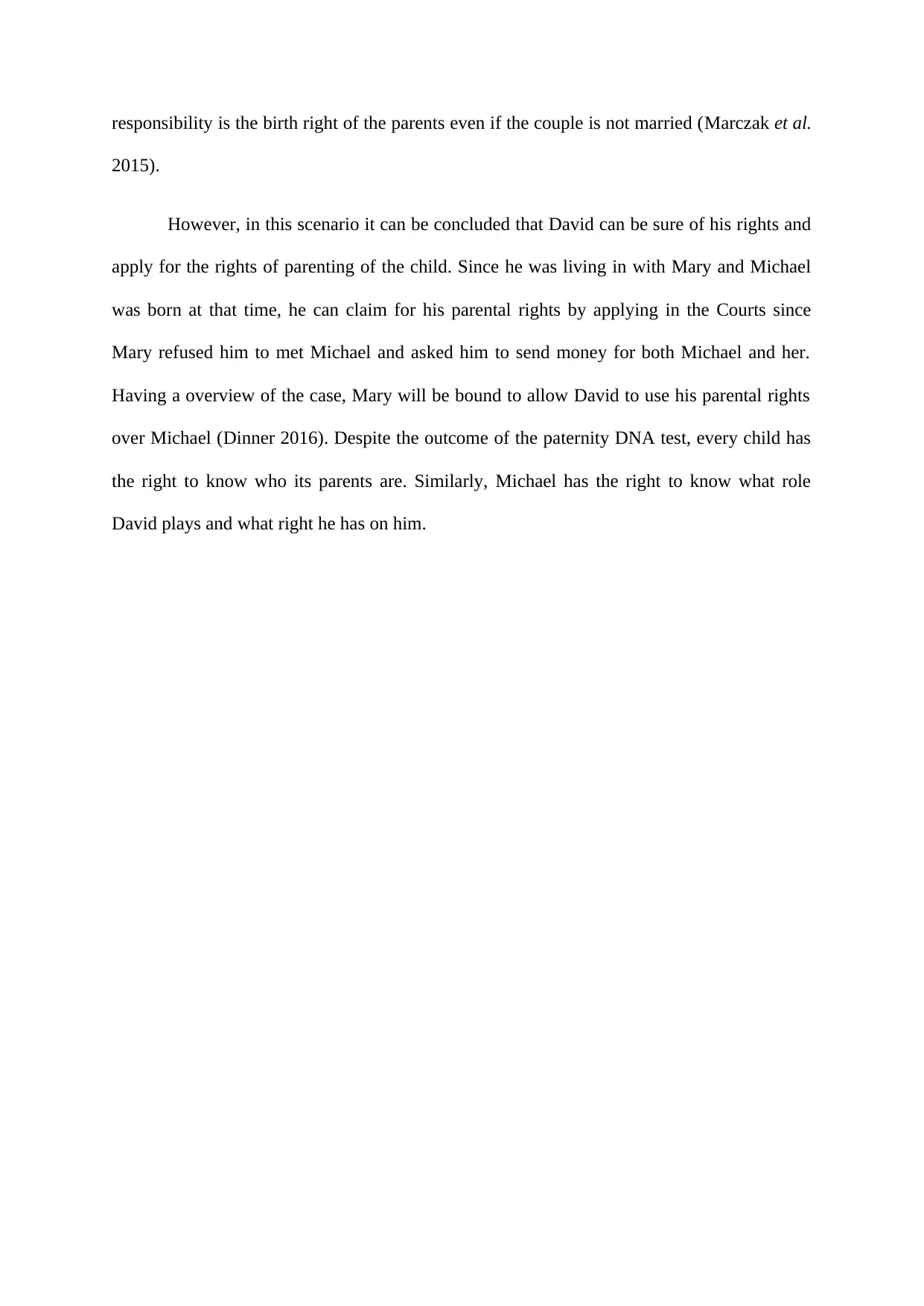
responsibility is the birth right of the parents even if the couple is not married (Marczak et al.
2015).
However, in this scenario it can be concluded that David can be sure of his rights and
apply for the rights of parenting of the child. Since he was living in with Mary and Michael
was born at that time, he can claim for his parental rights by applying in the Courts since
Mary refused him to met Michael and asked him to send money for both Michael and her.
Having a overview of the case, Mary will be bound to allow David to use his parental rights
over Michael (Dinner 2016). Despite the outcome of the paternity DNA test, every child has
the right to know who its parents are. Similarly, Michael has the right to know what role
David plays and what right he has on him.
2015).
However, in this scenario it can be concluded that David can be sure of his rights and
apply for the rights of parenting of the child. Since he was living in with Mary and Michael
was born at that time, he can claim for his parental rights by applying in the Courts since
Mary refused him to met Michael and asked him to send money for both Michael and her.
Having a overview of the case, Mary will be bound to allow David to use his parental rights
over Michael (Dinner 2016). Despite the outcome of the paternity DNA test, every child has
the right to know who its parents are. Similarly, Michael has the right to know what role
David plays and what right he has on him.
Paraphrase This Document
Need a fresh take? Get an instant paraphrase of this document with our AI Paraphraser
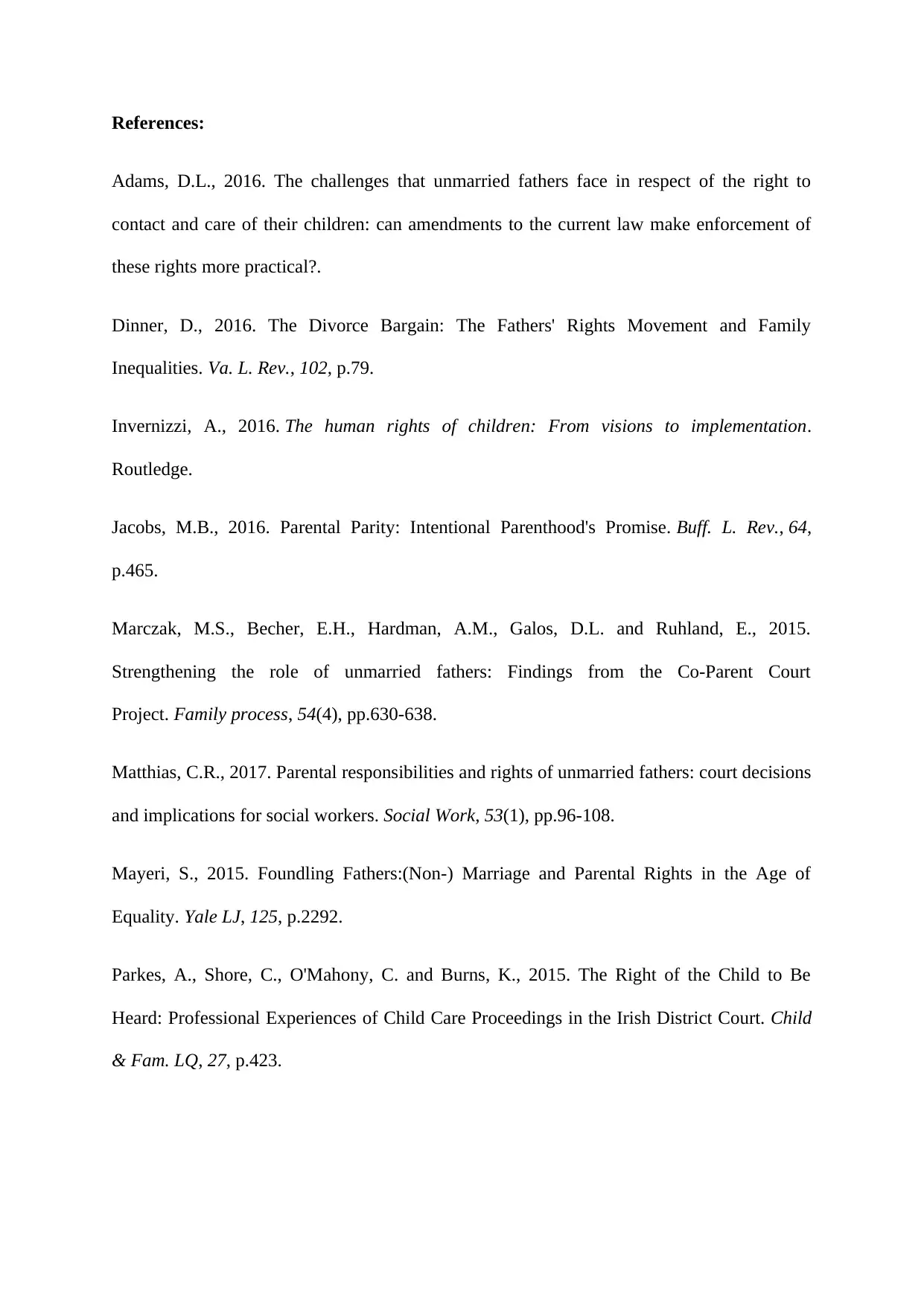
References:
Adams, D.L., 2016. The challenges that unmarried fathers face in respect of the right to
contact and care of their children: can amendments to the current law make enforcement of
these rights more practical?.
Dinner, D., 2016. The Divorce Bargain: The Fathers' Rights Movement and Family
Inequalities. Va. L. Rev., 102, p.79.
Invernizzi, A., 2016. The human rights of children: From visions to implementation.
Routledge.
Jacobs, M.B., 2016. Parental Parity: Intentional Parenthood's Promise. Buff. L. Rev., 64,
p.465.
Marczak, M.S., Becher, E.H., Hardman, A.M., Galos, D.L. and Ruhland, E., 2015.
Strengthening the role of unmarried fathers: Findings from the Co‐Parent Court
Project. Family process, 54(4), pp.630-638.
Matthias, C.R., 2017. Parental responsibilities and rights of unmarried fathers: court decisions
and implications for social workers. Social Work, 53(1), pp.96-108.
Mayeri, S., 2015. Foundling Fathers:(Non-) Marriage and Parental Rights in the Age of
Equality. Yale LJ, 125, p.2292.
Parkes, A., Shore, C., O'Mahony, C. and Burns, K., 2015. The Right of the Child to Be
Heard: Professional Experiences of Child Care Proceedings in the Irish District Court. Child
& Fam. LQ, 27, p.423.
Adams, D.L., 2016. The challenges that unmarried fathers face in respect of the right to
contact and care of their children: can amendments to the current law make enforcement of
these rights more practical?.
Dinner, D., 2016. The Divorce Bargain: The Fathers' Rights Movement and Family
Inequalities. Va. L. Rev., 102, p.79.
Invernizzi, A., 2016. The human rights of children: From visions to implementation.
Routledge.
Jacobs, M.B., 2016. Parental Parity: Intentional Parenthood's Promise. Buff. L. Rev., 64,
p.465.
Marczak, M.S., Becher, E.H., Hardman, A.M., Galos, D.L. and Ruhland, E., 2015.
Strengthening the role of unmarried fathers: Findings from the Co‐Parent Court
Project. Family process, 54(4), pp.630-638.
Matthias, C.R., 2017. Parental responsibilities and rights of unmarried fathers: court decisions
and implications for social workers. Social Work, 53(1), pp.96-108.
Mayeri, S., 2015. Foundling Fathers:(Non-) Marriage and Parental Rights in the Age of
Equality. Yale LJ, 125, p.2292.
Parkes, A., Shore, C., O'Mahony, C. and Burns, K., 2015. The Right of the Child to Be
Heard: Professional Experiences of Child Care Proceedings in the Irish District Court. Child
& Fam. LQ, 27, p.423.
1 out of 5
Related Documents
Your All-in-One AI-Powered Toolkit for Academic Success.
+13062052269
info@desklib.com
Available 24*7 on WhatsApp / Email
![[object Object]](/_next/static/media/star-bottom.7253800d.svg)
Unlock your academic potential
Copyright © 2020–2025 A2Z Services. All Rights Reserved. Developed and managed by ZUCOL.





